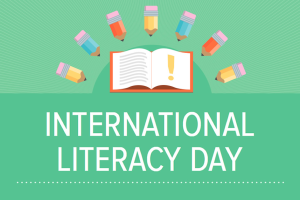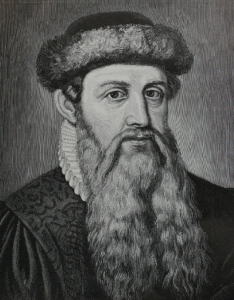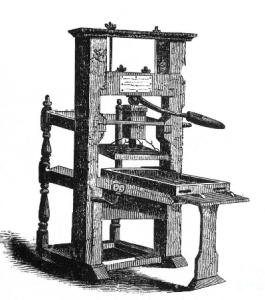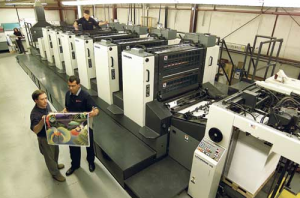By Margueritte Peterson
As everyone (at least, everyone who is reading this blog) probably knows, the advent of the Printing Press in 1454 (the year the Gutenberg Bible was printed) instigated a major boom in reading and literacy worldwide. Suddenly even the common man could afford a booklet or even a book… there was no longer an aristocratic or religious hold on reading! Huzzah! But how much did it really and truly do? The results are endless. In honor of International Literacy Day, we’d like to take a look at the beginnings of printing for the masses and how it helped shaped the modern world.
A long, long time ago (not in a galaxy far away), in the 13th & 14th centuries, printing used a technique now known as “block-printing”. Characters and images were literally carved into a block of wood, ink was poured into the crevices, and then the block was pressed onto paper. You can imagine how time consuming and expensive this method was, as each block of words or pictures had to be carved by hand. As “trendy” as woodcuts are now in fine press items, back then they were almost a nuisance – the wooden blocks tended to break after too much use and once a single thing changed within the image an entirely new block would need to be created. As governments and businesses grew to realize the importance of written records in their lives, demand for an easier printing technique became apparent.
Though several print specialists were looking into faster & easier ways to print for the masses with moveable metal type, the first to make his mark was the well-known Johannes Gutenberg, an aristocrat from Mainz, Germany. Born in 1398, he was in his 50s when his fame spread far for his invention developed with an alloy of lead and tin that would be more durable and far easier to re-use when placed in a printing press. In his format, the reusable separate pieces of type would be placed in the press, and then the mirror images of each letter were carved in relief to create words. And since the letters could be rearranged into any format – the possibilities were endless! Any type of writing could be printed – finally printing was not only a technique used for the wealthy or the church.
In 1452 at the age of 54, Johannes Gutenberg was finally able to get the necessary funds together to begin what would become his legacy – the Gutenberg Bible. He printed two hundred copies of his Bible in 1454 and sold many of them (for very large sums of money) in 1455 at the Frankfurt Book Fair (glad to know Book Fairs were enjoyed even so long ago!) According to one online source, the Bibles cost the equivalent of three years’ pay “for the average clerk.” (So available for the masses, but sort of not.)
In less than 50 years, over twenty-five hundred European cities boasted printing presses, and the technique grew and spread like wildfire. Of course its immediate effect was that it multiplied by hundreds the production of the written word, and also (quickly) cut the cost of books to an affordable treat. A large population of the world was hungry for information, and the printing press was able to give them what they needed. Though at first the texts still mainly dealt with religious subjects, they soon dealt with a variety of topics and were purchased and read by all kinds of people – scientists, students, businessmen and nobility all benefitted from the advance in printing technology. The advances in many fields (particularly in science and technology) were obvious – the propagation of knowledge in a form available to all manner of people made the sharing of ideas and observations all the more easy.
In a way, the advent of the printing press in the mid 15th century could easily be compared with the spreading of ideas via the internet currently. A quick and easy (not to mention cheap) way of spreading religious, scientific, political and moral thoughts and conceptions went “viral” and literacy rates worldwide boomed in the 1500s. On today, International Literacy Day, we should give thanks to the invention that (in a way) started it all! All hail the moveable type printing press!





